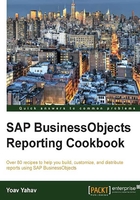
Working with different objects of the BI launch pad
Working with objects in the BI launch pad can be categorized into two main types:
- Reports: Working with the different types of reports created by the various BI applications such as Web Intelligence, Crystal Report, Analysis, and Explorer
- Non-report objects or simply BI launch pad objects: Publications (advanced schedule objects), hyperlinks, folders, categories, and local files are used mainly for organizing objects, scheduling, and adding external files such as office files
Getting ready
We want to understand the basic difference between folders and categories.
Folders and categories are both used for report organizing and grouping, while folders can be seen as the physical layer that actually contains the files, and categories are the logical layer enabling report navigation and can be seen as a pointer to a folder.
The basic idea behind categories is that this structure supports multiple locations by using one report file.
The system administrator can give permissions to a folder while organizing the reports in a totally different category structure.
How to do it...
We want to add one of the reports to a category. We will right-click on one of our reports and choose Categories, as shown in the following screenshot:

In the next screen, we will chose the category that we want to add the report to:

After adding the report to the category, we can navigate to the report and confirm that the report is there, as shown in the following screenshot:

How it works...
As we have seen, the BI launch pad is the heart of the SAP BI environment that contains all kinds of different objects: report file types, scheduled objects, hyperlinks, and other type of objects.
All the objects can be organized in a folder structure and can be grouped in a category structure as well.
Once we have the basic structure of the report's folders, we can allow users from the entire organization to access, share, send, edit, and create reports in one secured and easily accessed environment.
By enabling different types of objects to be hosted at the same environment, the organization can adopt a centralized approach towards its BI content, and can manage and run the reports, automatic scheduled jobs, users, and other standard repository objects that can be accessed through workstations, laptops, mobile devices, and tablets.